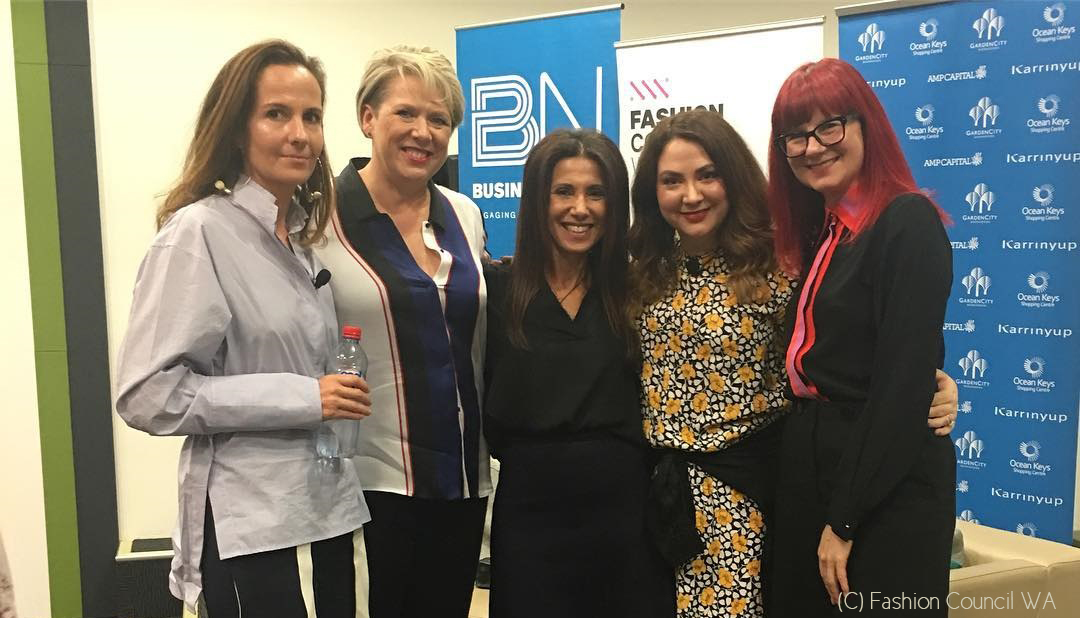The Evolving Retail Landscape: Finding Your Best Fit
Categories Everything, Fashion Industry0 Comments
Alicia Kemp, Fashion Category Executive for AMP Capital Shopping Centres; Antonia Leigh, who has worked closely with Alicia Kemp as a Fashion Marketing Creative through her eponym business Antonia Leigh PR and Zara Bryson, WA-based super star stylist and co-founder of the Peach & Pineapple Co. Agency were brought together by the Fashion Council of WA to talk about the experience and thoughts about the evolution of the retail landscape, especially in WA.

I loved the dynamism and wealth of experience that each speaker brought to the evening, and particularly liked Alicia Kemp’s direct and honest approach to business and profitability in the industry. In my opinion, the key points to take out from the forum in regarding the evolution of retail were the necessity for brands and designers to maintain and create a sense of urgency for the consumers in more innovative ways whilst respecting the true nature of their brand’s DNA, the absolute necessity to create a coherent brand experience across physical and digital stores, and the need for brands to adopt a less-is-more approach in a society where “slow” business is increasingly popular.
The need to create a sense of urgency in order to foster sales in nothing new, but recent changes in buying power and habits and the development of online platforms have given customers a greater access to information that can potentially delay their purchases; meaning less opportunity for impulsive shopping. The sense of urgency is still relevant, but needs to be created and fostered through different means, such as great and unique shopping experience, customisation and the use of social influencers.
Consumers have now a near-limitless access to information when it comes to your brand and products. Online reviews, comparative sites, even app reviewing your ethical standards enable customers to pick and choose their brands based on their positioning and brand DNA. To survive in this market,being relevant, which means understanding your key customer target, and ensuring an honest and direct dialogue with them is vital to enable growth and maintain sales. This also means that brands, designers and retailers must ensure that the same effort is put into building valuable online shopping experiences. There are new websites popping-up every day, and customers are growing weary of poor e-commerce customer service, so investing in great user experience, safe and transparent checkout options and building a web-specific content strategy is vital to make your customers want to engage and come back.
With the boom in social media, digital and mobile use, a lot of brands have gone all-in with the unique goal to make as much noise as possible, on as many channels as possible, as often possible. They are tired of it, we are tired of it, and mostly customers are growingly getting annoyed as this curated but not necessarily original content. Customers want more attention, more customisation and less spamming. Understanding your target market, building communication strategies with long-term goals rather that short-term quick gain tactics will allow your brand to grow more sustainably and truthfully with your customers.
Interestingly, the conversation mostly focused on customer experience within shopping centres (vs. street shopping) and big brands as opposed to small(er) labels and independent retailers. This could be solely due to area of expertise of the speakers, or could maybe was a more revealing indication of the evolution of buying – and general living – habits from street/ local communities to big shopping centres. As Alicia Kemp noted, nowadays, you can pretty much do anything in a shopping centre, from catching-up for a drink to catching-up on your botox fillings.
The growth of ethical and sustainable consciousness in Fashion was only touched-on during the Q&A, and was merely seen as a marketing tactic and a way for brands to get good points with their customers base than a real urge to do things differently. As the “SLOW” movement was also briefly mentioned, I can only hope that this will become a more pressing issue in the coming years.
In all consideration, it was a very interesting evening although I wondered how much novelty it brought in terms of in-depth analysis of the actual evolution of the retail landscape. Making products that customers want building a brand that is relevant to their audience is not a new concept; however it seems that it will become a critical aspect of survival for brands and retailers as the competition in the industry increases, the buying power decreases and new players such as Amazon aggressively enter the Australian market.
